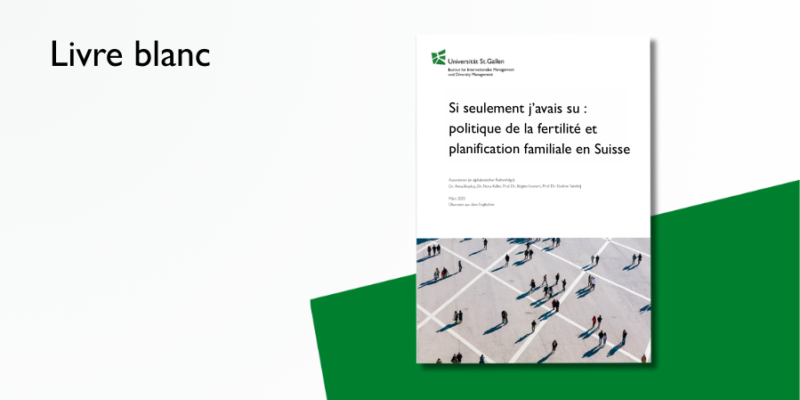
How to deal with unconscious biases in human resources decisions
Kategorie
HRAbstract How do unconscious biases shape crucial personnel decisions recruitment and promotions in companies and organizations?
This chapter shows how implicit biases about gender, race, looks, nationality or age can crucially influence managers’ and human resources (HR) personnel’s decision-making without their ever being aware of it. This can create companies that are not inclusive of heterogeneous backgrounds, where decision-making is not transparent and where employees feel unfairly treated. While inclusive, transparent workplaces for all genders and minorities are intrinsically desirable, this chapter also discusses how unconscious biases can negatively affect companies’ bottom lines. Conversely, if managers learn to critically reflect on their own implicitly held biases and implement HR processes designed to counteract unconscious biases, this is a big step in the direction of inclusive leadership and diverse, inclusive and transparent companies. In this chapter, we primarily address SDGs #5 (gender equality) and #10 (reduced inequality) but also SDG #8 on decent work, as inclusive, unbiased leadership can create a place of work where everyone, irrespective of background, feels included, safe and empowered.
Introduction How do unconscious biases shape crucial personnel decisions in companies and organizations? Managers – often together with human resources (HR) professionals – decide on new hires, promotions, salaries, salary increases, training initiatives, further education and team composition. In addition, managers are decisive in setting the tone for company culture. Hence, they should critically reflect on their unconscious biases when making such important decisions. Successfully doing so will contribute significantly to a more inclusive company. Unconscious (or implicit) biases are automatic associations or stereotypes about groups of people happening outside our conscious awareness. According to Herbert (2013), “unconscious bias . . . is a bias that happens automatically and is triggered by our brain making quick judgments and assessments of people.” Such judgments can be based on a difference in gender, sexual orientation or ethnicity and numerous other factors. Managers who reflect on and counteract their unconscious biases are more likely to be inclusive leaders. Inclusive leaders embody a leadership approach that appreciates diversity, invites everyone’s individual contribution and encourages full engagement during joint tasks (Bortini et al., 2016). Particularly for minority or underrepresented employee groups, such as women or people of color, inclusive leadership is an important prerequisite to feel fully included in teams (Shore et al., 2011). However, the benefits of inclusive leadership are not limited to minority groups; inclusive work environments offer equal opportunities to all employees to develop their full potential.
Apart from considerations of fairness and transparency, companies can reap tangible benefits from actively promoting diversity. If managed effectively, diverse teams are more likely to reexamine facts and remain objective, process information more carefully and come up with more creative solutions than homogeneous teams (Rock and Grant, 2016). Employees will be more content and motivated if promotion processes are as unbiased and transparent as possible. In turn, highly motivated and engaged employees will work harder, identify more strongly with their company and stay there longer. Thus, a climate of inclusion can decrease the turnover rate within a company, saving it from spending money on retraining new employees (Nishii, 2013). The 2015 “Diversity Matters” McKinsey report of 366 public companies even indicated that those in the top quartile for ethnic and racial diversity in management were 35 percent more likely to experience financial returns above their respective industry mean (McKinsey, 2015).
Unconscious biases at the workplace are connected closely to several sustainable development goals (SDGs), and limiting the influence of unconscious biases at work can get us a step closer to achieving several of these important milestones. First, gender stereotypes are a widespread cause of unconscious biases, which can prevent women from getting important opportunities or well-deserved recognition and remuneration for their work. Thus, SDG #5 (gender equality) is particularly relevant here. Second, unconscious biases can exacerbate workplace inequality (SDG #10): Biases can cause us to judge women, minorities, obese people and elderly people by different standards than members of the dominant group in an organization, eventually considering them less skilled and qualified. This reinforces existing patterns of inequality at the workplace. Finally, inclusive, unbiased leadership can contribute to a place of work where everyone, irrespective of their background, feels included, safe and empowered (SDG #8 on decent work).
This chapter explores how inclusive leadership helps companies reduce unconscious biases in HR processes and decisions. It argues that both managers reflecting on their own unconscious biases and de-biasing management processes are crucial prerequisites for inclusive leadership. First, the term “unconscious bias” is defined and then it is shown why it is important for managers to critically examine their own biases and alter their behavior accordingly. The chapter then focuses on recruitment and promotion processes, taking into account that both line managers and HR professionals are involved in these. Reference is made to the authors’ own long-term research projects on diversity and inclusion practices with clients from different industries (banking, insurance, public sector, etc.) at the Competence Centre for Diversity & Inclusion (CCDI) at the University of St. Gallen (www.ccdi-unisg.ch) and to other seminal studies to show the impact of biased decision-making on companies and their employees.
Unconscious biases
Also known as implicit biases, unconscious biases are automatic stereotypes about groups of people outside our conscious awareness (Herbert, 2013). We all have unconscious biases regardless of how open minded we consider ourselves, and our implicit biases may run counter to our consciously held values. Unconscious biases stem from our tendency to stereotype people as members of particular groups (based on gender, sexuality, race, etc.) and to ascribe positive or negative attributes to them (Taylor, 1981). People typically feel comfortable with those who are like them (the so-called in-group), and less comfortable with those they do not recognize as members of this group (members of the “out-group”). By identifying someone as a member of the in-group or out-group, we implicitly limit our assessment of another person to a single attribute, ignoring many others (Crisp and Nicel, 2004).
At their core, unconscious biases are mental shortcuts to make sense of enormous complexity: Neuroscientists estimate that we absorb ten million bytes of information every second. However, the human brain only consciously processes 0.00004 percent of this (von Kopp, 2015). In other words, we constantly filter and sort information upon which to base value judgments, decisions and actions outside our conscious awareness (Kahneman, 2011). Unconscious biases come from our particular experiences, education, media, cultural influences and other external influences.
Biases are not inherently negative (Herbert, 2013). Human ancestors would not have survived without the ability to tell friend from foe in a split second. Unconscious biases help us reduce unfathomable complexity, simplify our daily lives, speed up decision-making, compensate for knowledge gaps and help us preserve mental stability and a sense of security. Conversely, by their reductive nature, unconscious biases affect our ability to make fair and objective decisions and misinterpret situations and information as our brain presents us with a foregone conclusion. Because we are not consciously aware of many of our biases, their effect is difficult to control. Unconscious biases multiply as we grow older, and they are particularly prominent within homogeneous groups of people, in stressful situations and during moments of uncertainty.
Unconscious biases can lead to discriminatory decisions and actions if we allow stereotypes to guide us. A stereotype is a generalization, idea or judgment about a group of people that is applied to a single person we identify as part of that group (Crisp and Nicel, 2004). For example, a common stereotype is to associate obesity with laziness. If hiring managers subscribe to this stereotype, they will conclude an obese job applicant is lazy and therefore unsuited for the position – and not hire him or her (Baitsch and Steiner, 2004). In this way, unconscious biases have led to discrimination – for example, the unfair or prejudicial treatment of people and groups based on characteristics such as race, gender, age or sexual orientation (American Psychological Association, 2018).
There are three types of unconscious biases relevant in this chapter. Through confirmation bias, we search for and focus on information that confirms beliefs we already hold, discounting information that runs counter to our ideas. The similarity or affinity bias makes us gravitate toward people similar to us, evaluating their ideas more positively than others’. This “mini-me effect” confirms the holder as a person and my special attributes in a positive way. This leads to homogeneous groups at risk of not considering all possible alternatives and making wrong decisions. Finally, attribution bias makes us falsely attribute other people’s actions to some flawed personal characteristic rather than situational factors. In a business context, supervisors attribute successful projects largely to the work of male collaborators while discounting the female labor that went into them (Kelley, 1973; Pohl, 2004; Gruman et al., 2017; Singh and Yan Ho, 2000).
It is crucial for business leaders to undergo the process of recognizing and examining their own unconscious biases. Most managers want to be good leaders who do not purposefully discriminate. When they make biased decisions, this has a huge impact on companies, especially on recruitment and promotions (hiring and promoting the “wrong” people). In turn, this influences employees’ ability to achieve their full potential. Therefore, managers should acknowledge and reflect upon their unconscious biases and change their behaviors and patterns in terms of more inclusive leadership. This is not only a discussion about fairness and equal opportunity; it also has an impact on the bottom line, development of talents, performance and the image of the organization. Crucially, organizations should offer unconscious bias training to both managers and employees to highlight the pervasiveness and effects of unconscious biases and help people to confront their own biases, which often is uncomfortable and difficult. Unconscious bias training should be on a voluntary basis to guarantee high levels of engagement and motivation of training participants (Dobbin and Kalev, 2016).
Unconscious biases and recruitment
When it comes to vacancies, employment ads and recruitment, managers’ biased decisions strongly influence whether certain groups have a chance to enter the company. Unconscious biases can permeate the entire recruiting process, starting with job postings and ranging from the invitation to interview and the interviews themselves to making an offer to the favored candidate.
Biases play a poignant role during initial candidate selection, where recruiters field a large number of applicants with little time to get a full picture of each. The similarity or affinity bias can play a significant role: Companies risk excluding high potentials from continuing in the hiring process only because they are different from the interviewer or the incumbent holding the position. As companies are not recruiting the best person for the job in this way, they are left less productive and profitable than they could be otherwise (Singh and Yan Ho, 2000).
Studies show the pervasiveness of biased decision-making during recruitment. For example, Weichselbaumer (2016) reports that foreign-sounding names and wearing a headscarf significantly depress positive responses and candidate preselection for otherwise identical job applications. In an experiment, 1,474 applications were submitted in response to job advertisements of companies located in Germany (where adding photos to CVs is the norm). The applicant with the German name was the most successful, receiving positive feedback from 18.8 percent of her applications. The applicant with the Turkish name wearing no headscarf had a response rate of 13.5 percent and the applicant with a Turkish name and headscarf fared worst, receiving positive feedback from only 4.2 percent of all companies contacted.
Not only should companies deliberately counteract biases during the initial screening of applications, they should also be vigilant about having a well-balanced candidate pool throughout the entire recruitment process. In a series of widely cited studies, Johnson et al. (2016) found that if there is only one woman in a finalist pool during a candidate search, there is virtually no chance that she will be hired. According to their experiment, a woman’s hiring chances increased by almost 80 times if there were two or more women in the finalist pool. One explanation is that a single woman in a group of men will be viewed as the “token” woman – and therefore not as deserving and qualified as men (Johnson et al., 2016; Kanter, 1977).
How can companies avoid the pitfalls of unconscious biases during recruitment? Luckily, several strategies can minimize bias and discrimination. When reviewing incoming applications, it may make sense to remove identifying information from résumés to avoid being influenced by applicants’ gender. A pilot study conducted by the German Anti-Discrimination Commission from 2010 to 2011 asked eight major companies and organizations to anonymize their application procedures (Krause et al., 2012). In this study, various anonymization methods were used to conceal any information that could point to gender, including names, photos, or even membership in gender-specific organizations. Recruiters were able to find equally well-qualified candidates as with traditional recruiting strategies, and many appreciated not being “distracted” from job-relevant information. Forty-one percent of applicants indicated that they believed anonymization increased their chances of being invited to interview. Overall, all organizations found that the rate of discrimination decreased due to the intervention, though the anonymization procedure should be chosen with care to avoid the loss of crucial information.
Apart from anonymization, recruiters may consider women’s and men’s résumés separately and pick top candidates from each, then compare them against each other at the end. Candidates should be screened by multiple people, asked the same questions in the same order during interviews and evaluated based on identical criteria (Herbert, 2013). This minimizes the amount of leeway for recruiters to judge candidates based on unconscious biases. During each round of candidate eliminations, recruiters or line managers should reconsider the number of minorities still in the running and ask themselves honestly whether the small percentage of minorities in the final round is due to unconscious biases. The order of interviews can be used strategically: Recruiters should consider inviting a favorite candidate to interview last, to allow interviewers to keep an open mind while interviewing less favored candidates (and the recruiters may be surprised by the results). After the interviews, recruiters should ask themselves honestly: Would I have asked a man/woman this question? Would I have asked this question to an older/younger person? Would I have asked this question to someone from my own/another nationality?
Unconscious biases and promotions
Even if an institution is able to onboard a diverse staff, this unfortunately does not mean that they are also able to develop them. How do unconscious biases influence human resource development regarding promotions and retention?
Many companies have a quite diverse workforce overall. For example, the recent McKinsey and Lean In (2018) study found that women made up 48 percent of the entry-level workforce in the United States. ADVANCE and CCDI (2018) found similar patterns for Swiss companies. Nevertheless, at higher management levels, especially on the board or top-management level, the degree of diversity decreases significantly (Hambrick, 2007; Kilduff et al., 2000). In the United States in 2018, at the top level of management, 22 percent of employees were women (McKinsey and Lean In, 2018). In Switzerland, 51 percent of nonmanagement employees were women, but only 15 percent at the top-management level (ADVANCE and Competence Centre for Diversity and Inclusion, 2018). This means that retention and promotion of a diverse workforce remains a significant challenge for companies and business today that must (and can) be addressed.
Biased decision-making plays a crucial role during professional development and promotion processes. Similarity and attribution biases can cause male supervisors to unconsciously view other men more favorably and attribute successful projects largely to male collaborators. Supervisors may also evaluate men based on their potential and women based on their specific experience (Ibarra et al., 2010).
Age and age differences can also trigger unconscious biases. A CCDI study (2017) shows that the age difference between employee and supervisor can have a significant impact on performance evaluation. If the supervisor is younger than the employee, the performance evaluation significantly worsens as age difference increases. If the supervisor is older than the employee, the opposite is the case – the larger the age difference, the better the performance evaluation. The study further reveals that men receive significantly more positive evaluations of their development potential than women do. Another study by the chapter authors’ organization shows a marginalized group effect (CCDI, 2017), whereby members of the dominant group tend to evaluate members of its group more favorably than members of the marginalized group. Members of the marginalized group are stricter in their evaluations in general, but especially when it comes to evaluating employees of their own (marginalized) group (CCDI, 2017). One possible reason for this is that minority managers, due to their small number, feel like they are under closer scrutiny than their non-minority peers. According to this logic, they are more scrupulous in their evaluations, especially of other members of their minority group, to avoid charges of favoritism. If employees feel their evaluation was unfair, they are more likely to leave the company for opportunities elsewhere.
The 2018 Gender Intelligence Report for Switzerland by ADVANCE and CCDI shows evidence that both promotions in general and promotions to management clearly favor employees working full time. In Switzerland, women often work part time. As such, women face higher obstacles to promotion than men, even when working very close to full time (80 percent and above) and even during the initial promotion from nonmanagement to the first management level. What are some strategies to mitigate unconscious biases during promotion processes, thereby reducing the turnover rate and retaining a more diverse workforce at all hierarchy levels?
It is vital that managers be trained and sensitized to foster, promote and model sustainable approaches to diversity and unconscious biases during the personnel development and promotion processes. Managers should ask themselves if they are really promoting the best team members (based on objective, verifiable criteria) or if they are favoring the “loudest” team member exhibiting the most confidence. Are members of the team periodically overlooked because they are more introverted or because they work part time or from home. Which team members do managers pay the most attention to? In which team members do they see the most development potential? Why? Not only should managers ask these questions and urge those below them in the hierarchy to do the same, but they should make it very clear that they strive for bias-free, transparent promotion and HR processes.
All HR processes should be “de-biased.” Effects should be measured regularly and processes adapted in response. For instance, a proposal to promote a specific employee should not only depend on the evaluation of the direct supervisor. Rather, feedback from different perspectives such as clients, peers and team members should also matter. All promotions should be discussed with several carefully composed circles that take potential biases and fair promotion goals into account in their decision-making. Another possibility is to shift promotion processes to follow an “opt out” logic. At Deloitte Switzerland, all women and all employees who work on 80 percent contracts are automatically part of the promotion pool. This puts line managers into the purposely uncomfortable position to argue against a woman’s (or minority group member’s) promotion instead of arguing why a woman should be promoted. This leads to a higher promotion rate for women, minorities and part-time employees.
Crucially, HR processes should not be “de-biased” in isolation; they should be part of a holistic diversity strategy driven by upper management. To foster an inclusive culture and leadership, a company must have a corporate culture that views diversity as important for the whole organization (Sander and Hartmann, 2019). This is best achieved through a so-called systemic approach (Dass and Parker, 1999) to managing diversity and inclusion, where diversity is viewed as a strategic issue, clearly communicated to both employees and stakeholders as such and linked to existing systems and core activities. It is important that supervisors be assigned diversity-related goals and monitored accordingly and that there are rewards and sanctions associated with (non)compliance (Dobbin and Kalev, 2016). Sometimes, one hears the criticism that such an approach might lead to a less qualified minority candidate being hired over a more qualified candidate without a diverse background. If quotas are worded and implemented smartly (“at equal qualification levels”) and coupled with transparent evaluation criteria to measure respectively how qualified candidates are, it is highly unlikely that this would happen. Day-to-day management processes should be reconsidered from an inclusion angle, ranging from core business processes like products and services offered to customers to support processes like quality management, human resources and accounting. This can help de-biasing management processes and also reduce unconscious biases in HR processes.
Conclusion
In order to lessen the impact of unconscious biases in company leadership and HR processes, it is crucial to examine personal unconscious biases and foster an inclusive working environment. It takes personal courage and a willingness to consider potentially unwelcome and uncomfortable aspects of our mental frameworks; after all, most people do not like to acknowledge their own potentially racist or sexist beliefs. By understanding the value in reducing personal biases, leaders and managers can move past the discomfort inherent in confronting implicit biases at odds with consciously held values and begin to acknowledge and eliminate blind spots. There are concrete mental steps to take in specific situations to avoid judgments and actions based on unconscious biases. For instance, to overcome confirmation bias, it helps to set clear and tangible criteria to form the basis of the decision-making process (Pohl, 2004). To sidestep attribution bias, it helps to question why we judge others as competent or incompetent, respectively (Heilman and Haynes, 2005). To avoid affinity bias, it can help to evaluate each team member’s individual contributions to a project as transparently as possible (Kanter, 1977).
Leaders who critically examine their own unconscious biases and consciously implement strategies to prevent unconscious biases from affecting decision-making are well on their way towards inclusive leadership. According to Shore et al. (2011), inclusive leadership is a prerequisite to boost inclusion in teams as managers shape the culture of the organizations, as their decisions influence the level of inclusiveness in teams and in the organization. Therefore, it is particularly important to raise awareness for unconscious biases on the managerial level and to de-bias management processes in order to guarantee high levels of inclusion and equal opportunities for all employees. In this regard, tracking key performance indicators for diversity and inclusion and measuring to what extent the employees perceive the work environment as inclusive can also help unconscious bias training for managers (and employees) support organizations and managers to overcome the danger of excluding diverse employees with high potential from key opportunities . Inclusive leadership skills will allow leaders to utilize to the fullest the advantages of diversity in those they manage, while leaders without inclusive leadership skills may get left behind.
Both de-biasing management processes and managers who reflect on their unconscious biases are important prerequisites for inclusive leadership, which in turn can lead to more inclusive work environments with an adequate representation of women and other minorities in the organization.
Das könnte Sie interessieren

DIVERSITY WORKS
Suchen Sie eine umfassende Lösung zur Messung und Optimierung von Diversity, Equity und Inclusion in Ihrer Organisation? Mit unseren DIVERSITY WORKS-Angeboten ermöglichen wir Ihnen zu verstehen, wo Sie auf Ihrer DE&I-Journey stehen und mit unserer Beratung und Expertise gezielte Massnahmen zu ergreifen.

Seminar: Successful Through Diversity & Inclusion
In the compact programme “Successful through Diversity & Inclusion”, you will gain an insight into how you can implement Diversity, Equity & Inclusion (DE&I) for the benefit of your company. You will deal with the cornerstones of modern corporate culture and DE&I-relevant leadership aspects and learn methods to set and realise DE&I goals. Using practical examples, you will learn about approaches that enable the introduction / implementation of DE&I in the context of the new working world.



